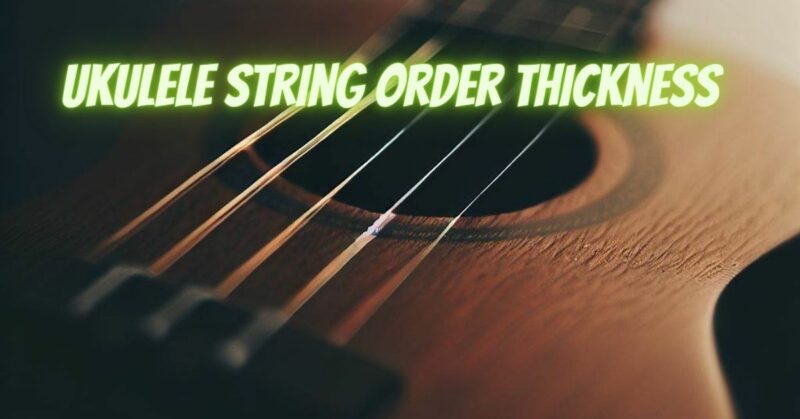Choosing the right strings for your ukulele is crucial for achieving the desired sound and playability. The order and thickness of ukulele strings play a significant role in determining the instrument’s tone, projection, and feel. In this article, we will explore the different string orders and thicknesses available for ukuleles, guiding you through the options and helping you make an informed decision based on your musical preferences and playing style.
- Common String Orders:
Ukuleles typically come in four string orders, each offering distinct tonal characteristics and playing experiences:
- GCEA: Also known as “re-entrant” tuning, this is the most common string order for soprano, concert, and tenor ukuleles. The strings, from top to bottom, are tuned to G, C, E, and A. The re-entrant tuning creates a bright and balanced sound, allowing for melodic exploration and chord versatility.
- DGBE: Known as “baritone” tuning, this string order is often used for baritone ukuleles. The strings, from top to bottom, are tuned to D, G, B, and E. Baritone tuning produces a deeper and richer tone, resembling that of a classical guitar.
- ADF#B: This string order, commonly referred to as “low G,” involves replacing the high G string with a lower-pitched G string. It is favored by players seeking a fuller sound and extended range. The strings, from top to bottom, are tuned to A, D, F#, and B.
- GDAE: This string order is often used for a ukulele-sized version of the traditional violin or mandolin. The strings, from top to bottom, are tuned to G, D, A, and E. It offers a unique tonal quality, allowing ukulele players to explore different musical genres.
- String Thickness:
Ukulele strings come in varying thicknesses, commonly referred to as “gauges.” The choice of string thickness affects the overall feel and sound of the instrument. Here are some common ukulele string gauges:
- Light Gauge: Light gauge strings are thinner and easier to play, making them ideal for beginners or players who prefer a softer touch. They produce a brighter and more treble-focused sound.
- Medium Gauge: Medium gauge strings strike a balance between playability and tonal richness. They offer a well-rounded sound with a blend of warmth and clarity, suitable for a wide range of musical styles.
- Heavy Gauge: Heavy gauge strings are thicker and provide increased volume and projection. They offer a more robust and resonant tone, favored by players who seek a deeper and richer sound.
- Finding the Right Fit:
Choosing the right string order and thickness is a personal preference that depends on your playing style, musical genre, and desired sound. Consider the following factors when selecting ukulele strings:
- Playing Style: Are you a strummer or fingerpicker? Different string orders and thicknesses may suit different playing techniques.
- Musical Genre: The genre of music you play can influence your string selection. Brighter strings may be preferred for traditional ukulele tunes, while deeper tones may be suitable for jazz or folk music.
- Experimentation: Don’t be afraid to try different string orders and thicknesses to discover your preferred sound. Explore various brands and materials, such as nylon or fluorocarbon, to find the strings that resonate with you.
Conclusion:
Understanding the options for ukulele string order and thickness empowers you to tailor your instrument’s sound and playability to your preferences. Whether you opt for the classic GCEA tuning, explore alternative string orders, or experiment with different gauges, the choice ultimately comes down to your musical style and desired tone. Take the time to experiment, listen to different string setups, and consult fellow ukulele players for recommendations. Finding the perfect string order and thickness will enhance your playing experience and bring out the best in your ukulele’s unique voice.


